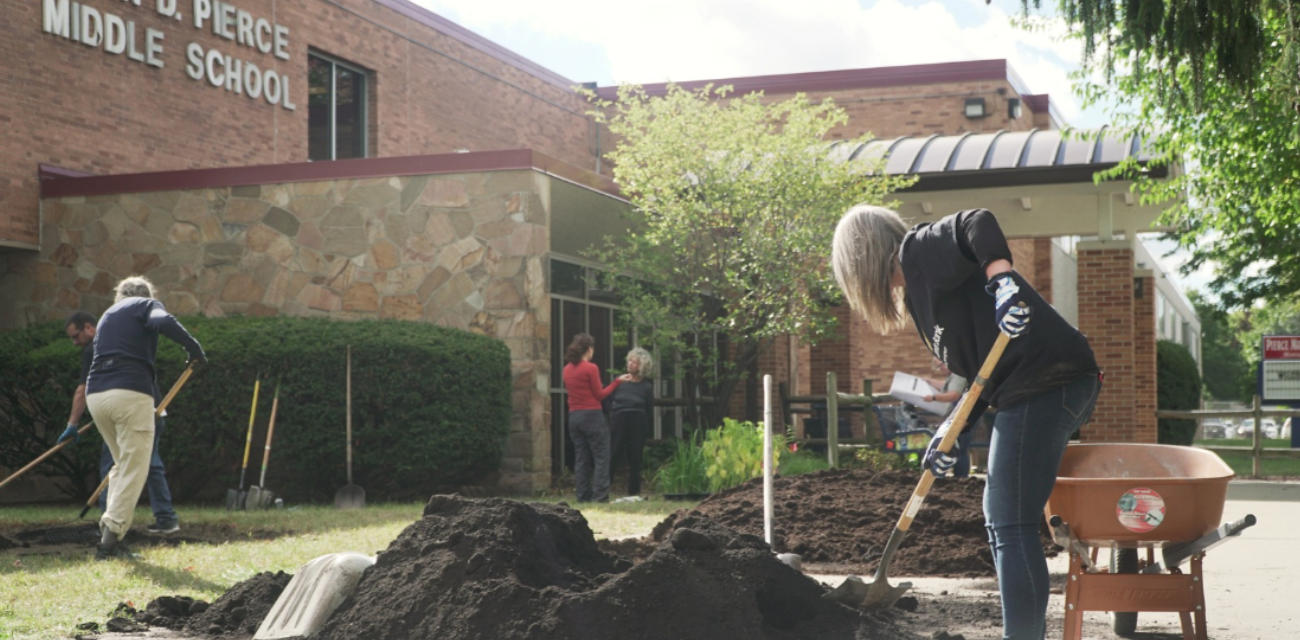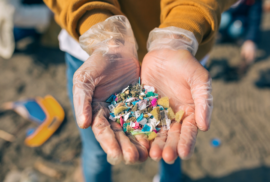In a sea of flooding, ever-growing oases rise

This story is part of the Michigan Environmental Council’s 2022 member magazine, “ECOsystems: Working Wonders With Water.” You can read the magazine in full here.
First came the floods. Sewer water gushed up from drains and onto the streets of Dearborn Heights. The river rose into nearby neighborhoods. Yards became knee-high pools and porches their steps into them.
Then came the stories. Basements flooded and molded. Thousands of dollars and cherished possessions were lost—furniture, heating systems, the keepsakes of lost relatives.
And all the while, often unseen, came the pollution. Overburdened sewer systems pumped contaminated water into the open. Floodwater picked up pesticides, heavy metals, motor oils. All of it traveled through communities, emptying into lakes, streams, drinking water, and the homes of both people and wildlife.
Then, weeks later, as these places were drying out, it all began again.
But not everywhere. In the midst of 2021’s historic flooding were hundreds of rain barrels that directed heavy stormwater away from yards and basements. There were scores of gardens that absorbed rain to keep office cubicles and classrooms dry. These were, more likely than not, the doing of Friends of the Rouge.
Climate change is ever ramping up. The United States’ infrastructure is scoring a “D” average on engineering assessments. The former creates more extreme weather events and the latter makes homes and habitats prone to their destruction. In the midst of this dual threat is Friends of the Rouge, an Environmental Council member group working to keep its namesake Rouge River Watershed safe and strong.
 “We’re protecting freshwater,” said Cyndi Ross, restoration manager. “We’re protecting these water resources that are drinking water to many. We’re protecting our Great Lakes, which is our economy.”
“We’re protecting freshwater,” said Cyndi Ross, restoration manager. “We’re protecting these water resources that are drinking water to many. We’re protecting our Great Lakes, which is our economy.”
Ross is at Pierce Middle School in Redford Charter Township, one of the hundreds of communities in Michigan prone to climate change-induced weather. Nearby are Friends of the Rouge volunteers, who have been trained to install four rain gardens on the school’s property. In a few years, these gardens will be flush with biodiverse, native ecosystems that absorb water of all amounts and intensities like a sponge.
This combination of community education and “green infrastructure” installation is key to Friends of the Rouge’s success. Its staff teach residents, governments, businesses, and schools about their namesake watershed, and then they work together to create infrastructure that helps our society run smoothly, from vegetated roofs to water-absorbing pavement.
The results have a snowball effect. Take the gardening at Pierce, for example. Projects like this may appear to only benefit the school immediately surrounding it. But these four gardens will lighten the load of stormwater and pollution for the surrounding neighborhood, blunting the punch of flooding, the spread of pollutants, and the destruction of homes and habitats.

The people who learned about and installed the rain gardens might then take what they’ve learned and apply it across this watershed of 1.5 million residents. Students, staff, and visitors to Pierce Middle School will see the beauty and learn of the power of the rain gardens. Friends of the Rouge’s work sparks a shift in thinking and feeling.
“If you’ve participated in a bug hunt, you never look at the water the same again,” said Ross, using another Friends of the Rouge program for comparison. “You see all that diversity of life and see the critters that are dependent on that water quality. And it really changes your view of the river.”
This combo of education, inspiration, and installation is happening across the state. Member groups protecting local lakes, streams, and watersheds are running similar programs, making real, impactful changes to the communities and ecosystems they serve.

Ross wants to capitalize on this Michigan-wide work. So, too, does Ross Gavin, the Environmental Council’s urban land use and infrastructure policy director.
He wants to take this patchwork action and make it a quilt. He wants to create a coalition that shares best practices for local communities, and he wants to help Friends of the Rouge and other member groups bring their tangible, cost-effective, and aesthetically pleasing solutions to Lansing to help the state government shift how it thinks about and funds water infrastructure.
The undertaking is substantial, but so are the threats of climate change and pollution.
“It really does impact everyone’s day-to-day life and can certainly impact it in a really negative way, whatever [one’s] political stripe, socioeconomic condition, or race,” Gavin said.
Learn more about Environmental Council membership here.
Fortunately, history is on our side, thanks to groups like Friends of the Rouge. When the nonprofit formed in 1986, exorbitant amounts of contaminants from riverside industry and business were being dumped into the Rouge River.
Now, thanks in part to Friends of the Rouge, the Rouge River Watershed is getting ever healthier.
“This was once the most polluted river in our nation, and we’re now paddling the river,” Ross said. “I didn’t think that would happen in my lifetime. And I’m amazed that it has, and I just can’t wait to see what happens as we move forward.”
Discover
Power environmental change today.
Your gift to the Michigan Environmental Council is a powerful investment in the air we breathe, our water and the places we love.
Sign up for environmental news & stories.
"*" indicates required fields





